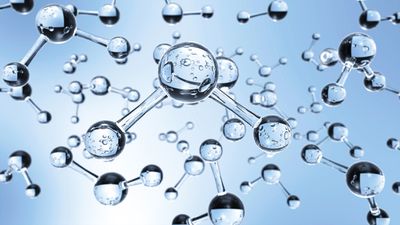
One of water’s important properties is that it is composed of polar molecules. The two hydrogen atoms and one oxygen atom within water molecules (H2O) form polar covalent bonds. While there is no net charge to a water molecule, the polarity of water creates a slightly positive charge on hydrogen and a slightly negative charge on oxygen, contributing to water’s properties of attraction. Water’s charges are generated because oxygen is more electronegative, or electron loving, than hydrogen. Thus, it is more likely that a shared electron would be found near the oxygen nucleus than the hydrogen nucleus. Since water is a nonlinear, or bent, molecule, the difference in electronegativities between the oxygen and hydrogen atoms generates the partial negative charge near the oxygen and partial positive charges near both hydrogens.
Water is not attracted to everything. Because water molecules are polar, they are more attracted to molecules that are also polar or that have a charge (like an ion). Some kinds of molecules, like oils and fats, are nonpolar. These nonpolar molecules have no charge, and so water is not very attracted to them.
Molecules of nonpolar compounds, such as oil and gasoline, even when mixed well into water, tend to separate from the water when the mixing stops. Water molecules tend to hold on to each other and squeeze out nonpolar oil and gasoline. Because of density differences between water and oil, this means that they form two separate liquid layers. For example, in oil-based salad dressings, the oil and water components separate into two layers and require mixing before being used.
Picture Credit : Google

